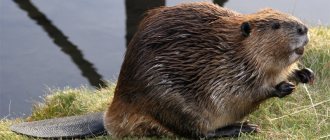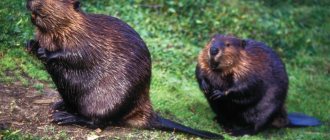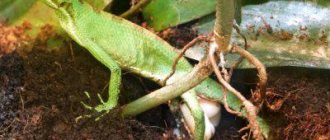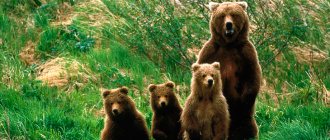You can eat beaver during Lent
At least if you're a Canadian Catholic. In 1760, the Parisian College of Physicians and Faculty of Theology officially declared the beaver a fish. Thanks to this decision, French Canadian settlers in North America had every right to eat beaver on fast days. After all, it has a scaly tail and lives in the water—everything is fair. By the way, Canadian trappers also tamed beavers to catch fish for them. So for them these were the most useful creatures in the world.
What does it eat?
Oh, the story ends...
Based on the type of nutrition, rodents are classified as herbivores. The beaver's diet includes about 200 species of hydrophytes, hygrophytes, and trees and shrubs. The animal's digestive system is adapted to the consumption of bark and other tough plant foods. In addition, beavers are coprophages. Periodically eating excrement with the bacteria it contains speeds up the digestion of stomach contents.
The composition of the diet depends on the time of year: in summer it is more varied and it is dominated by leaves and young shoots of plants; in early autumn, rodents switch to the bark and branches of bushes and trees. Beavers stock up on food for the cold season: in the fall, they take everything that could be useful for food into warehouses set up near their burrows. Animals chew through tree trunks, separate branches and small parts of the trunk and take them to storage. The roots of plants growing in water are also placed there. Due to the low water temperature, all beaver reserves are well preserved and allow the animal to survive the winter.
Beaver tail tastes like roast beef
Those in the know say that properly cooked beaver tail tastes like roast beef, that is, baked beef. The only problem is that it is quite gristly, and if prepared improperly, eating it can turn into torture. In addition, we must take into account that it is in the tail that the beaver stores fat and nutrients: in winter it is twice as thick, like a piece of pig, and in summer it is like an oar.
Lifestyle
River beavers live in burrows or semi-huts; they almost never build dams. They insulate their home with clay and branches. The entrance to this place is always under water. They spend the whole day at home and only go out towards dusk to get food. The teeth of these animals are very sharp: in half an hour a beaver can chew through a tree trunk.
River beavers can live either alone or in families. Matriarchy reigns in the social unit. Animals are monogamous, they create very strong pairs. Even if the partner died, the second one will not create a new family.
Rodents breed from February to April and mate mainly in March. 3-3.5 months after mating, cubs are born. The litter of animals usually contains from 1 to 5 cubs. After birth, the mother feeds them milk all summer. In winter, the offspring feed on their parents' food.
Sexual maturity in these rodents occurs as early as 3 years. One family contains both one-year-old and two-year-old beavers. In summer, young animals account for 26%, and adult river beavers account for more than 30%. Migrations aimed at searching for comfortable conditions are carried out only by two- to three-year-old mammals.
The beaver is not a hard worker, but a lazy one
The beaver is a born builder, literally. For him, building dams is not the conscious work of a hard worker, but almost a mania. He works on instinct: if a young beaver is placed in an enclosure where there is no running water or even trees, he will still try to build a dam. He is also able, without much effort, to fell a tree with a diameter of 16 cm in an hour. And with all this, the beaver is a rather lazy beast. In winter, for example, he leaves his hut no more than once every two weeks, preferring to relax and snore.
Common types
Today there are only two species of beavers - the Canadian and the Common beaver. The river or common beaver is common in Belarus, Kazakhstan, Luxembourg, France, Russia, Norway and Mongolia. The Canadian variety has chosen to live in most of Canada, and is also found in Mexico, Alaska, Poland, Karelia, Khabarovsk Territory, Germany, Austria and Sakhalin.
Common or Eurasian beaver (Castor fiber)
Representatives of this species are larger than Canadian beavers. Mature adults can grow up to 1.4 meters in length and weigh about 30–35.3 kg. The powerful and strong tail of the river beaver is about 24–36 cm long and 11 to 14 cm wide. Another difference from its Canadian counterpart is its longer tail and small ears. The main fur color can be light brown, dark chestnut or black. It prefers more delicate vegetation as food.
Canadian beaver (Castor canadensis)
This species has a more compact body, a broad chest and a shortened head. The ears are large and dark in color. The eyes are set close and slightly protruding. The body length of an adult Canadian beaver is from 83 to 122 cm, while the tail can grow from 23 to 52 cm. The body weight of an adult is from 11 to 28 kg. The main fur color is yellow or red-brown, sometimes black individuals are found. The undercoat is dense and thick, dark gray in color. Canadian beavers, unlike ordinary beavers, can eat coarser food of plant origin.
In general, the lifestyle of both varieties has virtually no differences. But the Canadian subspecies is less likely to settle in burrows and build huts. In addition, a dam built by a Canadian beaver often has a greater safety margin.
Final table of beaver species according to user ratings
Common beaver
1
Canadian beaver
0
People used to think that beavers chew off their eggs when they are scared.
A beaver as imagined by a medieval artist.
In Latin, beaver is caster, which, due to a misunderstanding, is similar to “castrato.” In addition, many people previously mistakenly believed that the valuable “beaver stream” (secretions of his anal glands) was extracted from his testicles. Because of these dubious facts, a belief has developed that the beaver allegedly bites off its eggs and genitals when it senses hunters. It’s like: “Take it and leave me alone!” Even the great men of antiquity fell for this canard: the medieval monks who compiled the bestiaries repeated it after Aesop and Pliny the Elder.
Habitats
It is not very difficult to determine where beavers live. Having noticed fallen trees with a characteristic cone-shaped cut near reservoirs, as well as ready-made dams built by animals, one can conclude that they are somewhere nearby. It would be great luck to come across a beaver’s home - this is already an unambiguous marker of the presence of a friendly family. They settle in slow-flowing forest rivers, streams, reservoirs, and lakes.
In the first decade of the last century, beavers in the wild could have completely disappeared in most countries of the world. Russia was no exception. Fortunately, the situation was corrected thanks to measures taken to protect these animals.
The river beaver now feels free throughout almost the entire country. The European part of Russia, the Yenisei basin, the southern part of Western Siberia, Kamchatka - these are the places where beavers live.
The largest beaver dam was discovered from satellite
Traveler Rob Mark in front of the largest beaver dam.
The largest beaver dam in the world was built in the Canadian wilderness. In northern Alberta, to be more precise. It stretches for 850 meters and was discovered by satellite in 2007. However, it began to be built at least in the 1970s, so it is the result of the efforts of many generations of beavers. In 2014, the dam was visited by researcher and New York Travel Club member Rob Mark. He had to walk for five days through the taiga and swamps, and he almost drowned in one of them. Arriving at the site, Rob was slightly disappointed, as the dam turned out to be quite low, overgrown and unphotogenic, and the beavers hid when they saw him. But in any case, he is glad that he became the first person to open the dam and calls it “his beaver Odyssey.”
Natural enemies
The beaver, despite its rather large size, has many enemies on land and under water. Typically, the victims of predators are old, sick or young animals.
Beavers are hunted by bears, dogs, wolves, wolverines, coyotes, otters, raccoon dogs and lynxes. Small beaver calves can be attacked by large birds of prey such as owls, eagles, eagle owls or white-tailed eagles. The cubs can also be eaten by large pike, catfish or taimen.
But still, fires and humans remain the main enemies of unusual rodents.
Beavers used to be gigantic. Around Mike Tyson
Castoroides ohioensis. Giant beaver.
Today's beavers, at their best, reach the height of a 10-year-old child (if they stand on their hind legs, of course). But in ancient times they were much larger. In North America during the Pleistocene there lived giant beavers Castoroides ohioensis, which weighed 125 kilograms and reached a length of 2.2 meters (with a tail - all 2.7). They were not only larger than the current ones, but also much stupider. Their brains were small relative to their bodies, meaning they likely lacked the complex behavioral patterns of modern beavers. Castoroides became extinct several thousand years ago, as did mammoths, mastodons and Ice Age horses - due to an environmental crisis. But the ancient hunters probably also helped: at least the Indians still have legends about giant beavers and the war with them.
Varieties
The beaver family has only two species: the common beaver, or river beaver, and the Canadian beaver. Let's take a closer look at the types of beavers.
River
This is a semi-aquatic animal, the largest rodent in size, inhabiting the Old World, the forest-steppe zone of Russia, Mongolia, and China. They settle along the banks of slow-flowing rivers, irrigation canals, lakes and other bodies of water, the banks of which are covered with trees and bushes.
Canadian
In appearance it differs from the river beaver in having a less elongated body, a short head and larger ears. The color is blackish or reddish brown. It lives throughout almost the entire United States (except for Florida and most of Nevada and California), in Canada, except for the northern regions.
It was brought to the Scandinavian countries, from where it independently penetrated into the Leningrad region and Karelia.
These two beaver species have different numbers of chromosomes and do not interbreed.
Beavers' eyelids act as glasses and their tails act as alarms.
Beavers are incredibly well adapted to the life of a dam builder. Much better than it might seem at first glance. They have clear eyelids that act like goggles and valves that cover their nostrils and ears while diving.
Beaver teeth are orange due to their high iron content, which makes them strong. In addition, their cutters are not uniform: the back of the edge is stronger than the front, which gives the effect of a self-sharpening blade. The beaver's tail not only works as an oar and fat storage, but also serves as a kind of stand-chair when it stands on the shore. It can also serve as a siren: a beaver that senses danger hits the water with its tail, and this sound alerts its buddies hundreds of meters around.
Reproduction and lifespan
Beavers' mating rituals take place in the second half of winter. And beaver cubs, the number of which can reach up to six, are born after three months (in Canadian beavers, pregnancy lasts longer). These cubs are blind and weigh approximately half a kilo. Then, throughout the warm season, on mother's milk, they quickly gain weight. However, by the time cold weather sets in, the beaver cubs are still not fully mature, and therefore spend the winter together with their parents.
Little beavers
And only when the young animals reach two years of age can they lead an independent existence, as well as search for and develop new territories. It is curious that female beavers, like people, have a manner of carrying their cubs in their arms, or rather, holding them in their front paws. These same limbs are also used by animals when they work, constructing their architectural masterpieces, which is what makes them unique among the animal world.
It is also interesting that the age of these creatures is very easily determined by their teeth. These adaptations given by nature play a vital role in the life of beavers, and therefore have a special structure. For example, the most developed among them are the upper incisors. And the older the individual, the wider its teeth become. The lifespan of these creatures in the wild is approximately known and is about 15 years.
The Laplanders used beaver stream along with tobacco.
Beaver glands.
Now beaver stream, castoreum, seems to be an overvalued resource. Well, yes, it has a musky scent with vanilla notes, and that is why it was used in perfumery. However, it was previously believed that this was practically a panacea for all diseases. Beaver stream was prescribed for headaches, fever, epilepsy and as a laxative. Until recently, Laplanders used castoreum together with snuff. By the way, beaver stream is still used in perfumery. Fortunately, it's synthetic.
Interesting Facts
There are many interesting and intriguing facts associated with this unusual animal. For example, historical sources indicate that the word “beaver” was the name of the animal, and the word “beaver” meant its skin. Now in the colloquial speech of modern people these words have become synonymous.
Interesting:
- The beaver is the only rodent on the planet that can build real houses and construct platinums. The uniqueness lies in the fact that all the building materials (sometimes quite large) are obtained by the animals themselves.
- Beavers were the first animals to be introduced into the reserve with the help of aviation. Around the 40s, the United States prepared special container boxes that were lowered to the ground by parachute and opened when they hit the ground. Thus, about 75 beavers found their new home.
- There is an international beaver day, which is celebrated on October 18th.
- And over the right to hunt beaver, armed conflicts arose between countries.
- In 2006, a real bronze beaver monument was erected in the city of Bobruisk. This sculpture has become the hallmark of the city. The monument is endowed with mystical properties; it is believed that if you stroke the nose of the bronze beaver, it can give the petitioners happiness and success.
It’s interesting, but attempts to keep beavers as pets almost always end in the flight or death of the animals. This is due to the fact that it is virtually impossible to provide semi-aquatic rodents with the usual standard of living at home. And only in exceptional cases do beavers adapt to their new place of residence.
You can admire construction rodents at the zoo. Employees create conditions that are as close to natural as possible. There the animals feel relatively comfortable, happily communicate with guests and breed. The only thing is that they are not allowed to build dams, dams or dig their usual holes.
Tyva Republic
Status: III category. Rare view. A small population distributed in Tuva over a limited area.
Spreading
Beavers of the Central Asian subspecies appeared on the territory of Tuva in the late 1980s. as a result of migration from the border Mongolian territory. There, in the lower reaches of the Tes River (Tes-Khem, Tesiin-gol), in order to reduce the risk of loss of the unique indigenous gene pool, a total of 37 beavers were introduced, brought from the mother population of the Bulgan River, Western Mongolia. Currently, the distribution area includes the Tuvan section of the Tes River (bed and floodplain oxbow lakes); single entries and temporary settlements are noted in the rivers Erzin, Naryn, Kosh-Terek, etc. The main core of the Tuvan population is located in the area from the state border at the Tsagaan-Tologoi border post to the mouth of the river. Erzin. The Tes River basin is the only habitat of beavers of the Cfbirulai subspecies within Russia.
Habitats
The key beaver habitats in the south of Tuva are floodplain lakes (oxbow lakes), which have sufficient depth, spring feeding, and do not freeze in winter. Beavers inhabit the main channel of the Tes River, its channels (sleeves) and a few tributaries during the ice-free period and use them as migration corridors. Dams are built on spring streams flowing from oxbow lakes.
Number
Within the Erzinsky and Tes-Khemsky kozhuuns of the Republic of Tyva, up to 50 individuals live. The total population in the Ubsunur Basin (Tuva + Mongolia) is estimated at 200 beavers.
Source: Red Book of the Republic of Tyva (animals, plants and mushrooms). Ed. S.O. Ondar, D.N. Shaulo (2018) Kyzyl
Tyumen region
Status: I category. An endangered species.
Spreading
Forest zone, forest-steppe and steppe of the Old World. The West Siberian subspecies inhabited in the past the entire territory of the Tyumen region south of 66 degrees north latitude (found in the Tyumen, Yalutorovsky and Ishim regions.
To date, there are separate habitats in the Konda river basins. Malaya Sosva and Demyanka. There is information about encounters in the upper reaches of the Demyanka rivers, Bolshoi and Maly Yugan, Vakh, Pur, Taz, in the upper and lower reaches of the river. Northern Sosva.
Protected in the Malaya Sosva nature reserve, in the Kondinsky nature reserve.
Number
The total number of the subspecies in 1995 was about 350 individuals (1960 - about 1000 individuals, 1970 - about 500).
Source: Red Book of the Tyumen Region. Animals, plants, mushrooms. Ed. V.N. Bolshakov, V.D. Bogdanov, A.G. Vasiliev et al. (2004) Ekaterinburg: Ural University Publishing House











